A flowering plum tree in the garden is every gardener's dream. Not only are they attractive, but the full bloom display they hold can have quite a startling effect on the beholder.
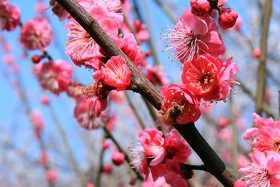 Enlarge Image
Enlarge Image
A flowering plum tree with its beautiful spray of pink flowers and purple foliage is one of the most beautiful ornamental garden tree that is used for decorative purposes in many landscaping designs. It is attractive as single specimen or massed together to line avenues and driveways.
The plum tree is a medium-sized tree which will reach 20 to 25 feet in height. It has a crown of 15 feet that comes to life every spring and winter. The flowers on the trees are a beautiful shade of pink, red or white, and have a strong fragrance. Unlike their productive counterparts, the ornamental or flowering plum trees do not produce any fruits.
While most of them are bred not to produce any fruit, some of them may have a small amount of fruit on it nevertheless. It is a must have for all those who like their landscape to go through transitions of colors and sing a different tune at the change of every season.
Types of Flowering Plum Trees
With Pink Flowers
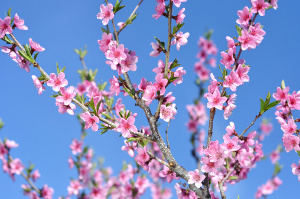
Thundercloud Purple Leaf Plum
Scientific name: Prunus cerasifera
Synonyms: Cherry plum, myrobalan plum.
Size: 15 to 25 feet height
Description
Thundercloud Purple Leaf Plum is deciduous tree with deep purple leaves and solitary, pink flowers. The bowl shaped flowers grow about 1-inch long, along the bare shoots of the tree in early spring.
Blireana Plum
Scientific name: Prunus × blireana
Synonyms: Purple-leafed plum
Size: 15 to 25 feet height
Description
The deciduous tree with ovate bronze or purple-red leaves has beautiful, showy dark-pink flowers in winter and spring.
Pissard Plum
Scientific name: Prunus cerasifera 'Atropurpurea'
Synonyms: Purple cherry plum, purple leaf plum, Newport cherry plum
Size: 15 to 25 feet height
Description
A small deciduous tree with alternate leaf arrangement and pinkish-white fragrant flowers that bloom in January and February.
Krauter Vesuvius Purple Leaf Plum
Scientific name: Prunus cerasifera 'Krauter Vesuvius'
Synonyms: Cherry plum
Size: 15 to 20 feet height
Description
'Krauter Vesuvius' with its dark reddish-purple leaves and pink bloom is a cultivar that typically grows as a dense, upright-rounded tree.
With White Flowers
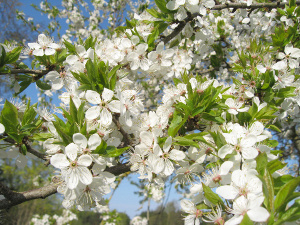
Pigeon Plum Tree
Scientific name: Coccoloba diversifolia
Synonyms: Pigeon Seagrape, doveplum, tietongue
Size: Medium to large (about 30 feet in height)
Description
A broadleaf-evergreen tree with dense, rounded canopy that produces small white-green flowers.
Chickasaw Plum Tree
Scientific name: Prunus angustifolia
Synonyms: Cherokee plum, sand plum, mountain cherry, Florida sand plum, sandhill plum
Size: 12 to 20 feet tall
Description
A plum tree that is native to North America, the Chickasaw Plum tree has a scaly-black bark with reddish side branches, and small oval-green leaves. In the months of February, March, April and May, the tree has fragrant, small-white blossoms with reddish-orange antlers.
Flatwoods Plum Tree
Scientific name: Prunus umbellata
Synonyms: Hog plum
Size: 12 to 20 feet height
Description
A small tree with oblong-lance shaped leaves, smooth, red brown to black bark, the Flatwoods plum tree has masses of showy white flowers in early spring. The flowers have five petals and multiple stamens and are borne in single or groups of five.
Other than these common flowering plum tree variants there are a number of dwarf and semi-dwarf plum trees like the Dwarf "Red-Leaf" plum (P. x cistena) and the "Dwarf Natal Plum" (Carissa macrocarpa) which grow to height of 5 to 7 feet. They are thus perfect for small yards and gardens.
Springtime sees the plum tree filled with clusters of white, pink or purple bloom that last several days. The flowers are sweet smelling with ability to spread their fragrance to quite a distance. The leaves sprout after the bloom fades away from the trees. With the approach of summer time, the leaves of the tree will change color from glossy green to deep, bright burgundy. The change in the foliage color leaves an everlasting impression on the eyes of the beholder. The fruits begin to appear late in the summer. The juicy fruits grow in clusters and are held together lightly. The fruits are small in size and upon reaching maturity turn red, pink or have tinges of purple.
Tree Care
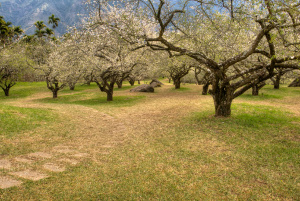
These trees are easy to grow and maintain. Good well drained soil, slightly acidic soil with a pH balance between three and six will result in good flower, as well as fruit production. They are not that fussy about soil, however, avoid places where water tends to stagnate. Young plants are especially partial to moist and well-drained soils. A sunny or a partially shaded location is best for growing a plum tree. Young plants need more water than established ones. Once the tree is established, water as per requirement. Fertilize before the flower bloom begins, and reduce when the tree has borne fruit and is in its dormant period. When adding fertilizer, spread it to the ends of each branch. While a young plum tree grows around 16 inches each year, an older tree will grow about 10 inches with proper care.
Diseases and Pests
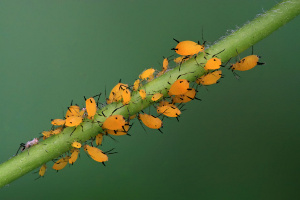
Black Knot: The most common disease that can affect this tree is the black knot. This disease can cause extensive damage to the entire tree, at times it may even kill it. Black knot is a fungus that occurs as black, rough galls or knots on the succulent stems and branches. It grows in the spring by the spores spread by air from any nearby tree that has been infected with black knot. The knots first appear green in color, and look like swelling in the stems. If unchecked, they infect the older branches and stems turning them black and hard. To deal with this fungus, remove the knots as soon as they appear. Cut the infected branch or trunk, and dispose them with proper care. During spring the fungus propagates actively and therefore all damage control measures need to be taken before spring sets in. An application of lime and sulfur, or any other fungicide will not only help eliminate the infection, but will also curb its spread.
Powdery mildew: It is a term to describe the fungal disease that results in white residue which coats leaf surfaces.
Prunus Ringspot: One of the most common viruses that affect all plum flowering trees, Prunus ringspot leads to yellow spots, rings and mottling. It results in stunted growth of the tree. The only way to prevent the virus from spreading is by removing the infected trees.
Bacterial Diseases: Certain bacterial pathogens like Xanthomonas lead to foliar diseases in the plum trees. If the leaves of the plum trees appear with small, round holes then it could be a result of the Shothole disease.
Pests: The most common pests that affect ornamental plum trees are tiny, soft-bodied insects known as aphids. Using some insecticides can kill insects that prey on aphids like lacewigs and ladybugs. To control the problem, spray them off with water. Prune out heavily infested leaves and stems. Other pests that affect the plum trees are tent caterpillars, spider mites and fruit-tree borers.
Pruning
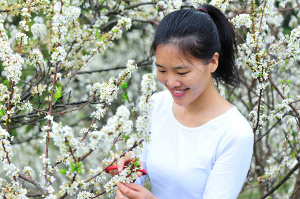
Pruning is essential for not just maintaining the shape and training the tree to a desired size but also in promoting healthy plant tissue especially when there are dead or dying branches. Pruning also helps in flower bud and fruit growth. There are three ways to prune; by crown reduction, thinning and pinching. Thinning helps in removal of weak limbs and stems while pinching of flower heads and twiggy offshoots help in controlling the plant's size. To maintain the tree's canopy and shape use crown reduction which involves removal of top portion of the tree has to be done.
Start pruning to shape young trees, just make sure you don't cut the main branch. Just snip out a few lateral steams to either maintain a design or encourage strong growth. The best time to prune a flowering plum is during their dormant period. Remove all diseased, damaged and weak branches. If a well-shaped crown is what you are aiming for then prune lower branches, or in dense crowns cut away some of the larger branches at the top of the tree. Use sharp garden tools like shears, lopping shears, hand saws, etc to get a good job done. For shorter branches use clippers like scissor action pruners, and pole pruners for large branches. If the branches are thicker than one-inch, use curved pruning saws. For well-established trees ask for professional help if you are not too sure about the way to go.
Fruitless flowering plum trees with their beautiful blooms decorate and add beauty to your landscape.Selecting the right plum tree and maintaining it well allows you to enjoy these blooms for years to come.






 Enlarge Image
A flowering plum tree with its beautiful spray of pink flowers and purple foliage is one of the most beautiful ornamental garden tree that is used for decorative purposes in many landscaping designs. It is attractive as single specimen or massed together to line avenues and driveways.
Enlarge Image
A flowering plum tree with its beautiful spray of pink flowers and purple foliage is one of the most beautiful ornamental garden tree that is used for decorative purposes in many landscaping designs. It is attractive as single specimen or massed together to line avenues and driveways. 



